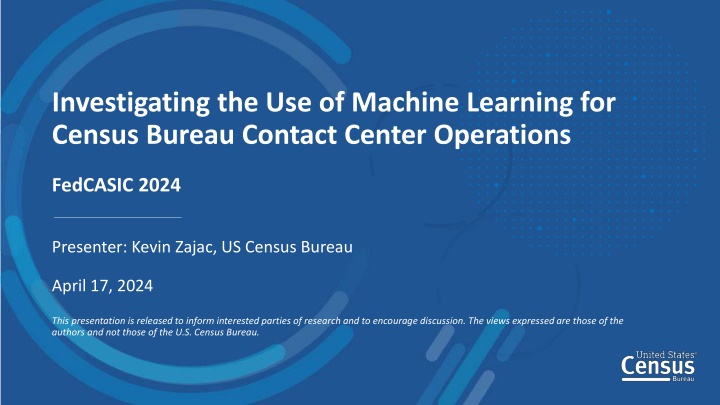
Machine Learning in Census Bureau Contact Center Operations Study
"Explore how Machine Learning (ML) can enhance Census Bureau contact center operations through automation, error reduction, and content improvement. Learn about research goals, methods, and challenges faced in implementing ML for a more efficient call experience. Presented by Kevin Zajac from the US Census Bureau on April 17, 2024."
Download Presentation

Please find below an Image/Link to download the presentation.
The content on the website is provided AS IS for your information and personal use only. It may not be sold, licensed, or shared on other websites without obtaining consent from the author. If you encounter any issues during the download, it is possible that the publisher has removed the file from their server.
You are allowed to download the files provided on this website for personal or commercial use, subject to the condition that they are used lawfully. All files are the property of their respective owners.
The content on the website is provided AS IS for your information and personal use only. It may not be sold, licensed, or shared on other websites without obtaining consent from the author.
E N D
Presentation Transcript
Investigating the Use of Machine Learning for Census Bureau Contact Center Operations FedCASIC 2024 Presenter: Kevin Zajac, US Census Bureau April 17, 2024 This presentation is released to inform interested parties of research and to encourage discussion. The views expressed are those of the authors and not those of the U.S. Census Bureau.
Agenda Introduction & Background Research Questions Methods Challenges Q&A/Audience Participation/Feedback 2
Introduction & Background Research Goal: Suggest improvements for Census Bureau contact center operations and enhance the overall call experience for callers and live agents by utilizing machine learning (ML) methods. Background: 2020 Census Questionnaire Assistance (CQA) contact center operation that provided answers to frequently asked questions (FAQs) and questions about items on the questionnaire; also collected response data Was handled by a large contractor. Utilized 11 physical contact centers across the United States. Supported English and 12 non-English languages. Used both Interactive Voice Response (IVR) system and live agents. Required agents to read answers to caller questions verbatim. Included a manual quality monitoring component. Recorded millions of interactions between callers and agents. 3
2020 Census Inbound Call Volume More than 50 percent of total inbound call volume was received within the first four weeks of operations. Agents are short term, don t necessarily have contact center experience, and need to get up to speed quickly. The Census Bureau's Disclosure Review Board and Disclosure Avoidance Officers have reviewed this information product for unauthorized disclosure of confidential information and have approved the disclosure avoidance practices applied to this release. (CBDRB-FY23-011) 4
Research Questions 1. Can ML be used to automate systems so that they are more efficient for the caller and for the agent? IVR so that the caller can speak their question in a natural way and receive a prerecorded answer, resulting in less calls needing to speak with a live agent. Live Agent so that the system allows an agent to find an answer to the call more quickly and accurately than through a manual process. 2. Can ML be used to automate processes, which would reduce human error and create a more uniform application of the processes across agents? 3. Can ML be used to identify improvements to the frequently asked questions (FAQs) and other content used by the operation? 5
Methods Primary data source for this research is audio recordings between callers and live agents during the 2020 Census. About 120,000 recorded calls in English, Spanish, and Chinese were used for this research (out of over 4.7 million recorded calls). Recorded audio calls were transcribed into text transcripts. Looked at several different open-source transcription models (approved for Census use). Compared transcription model text to manually transcribed text to evaluate. Developed models using various ML techniques to answer research questions. Always had to have a truth deck (developed manually) to evaluate effectiveness. Techniques used included transformer models, topic modeling, and fuzzy matching. 6
Challenges Staff knowledge with ML models and techniques. Resource issues due to manual transcription (needed to determine truth) and manual coding. Higher error levels associated with Spanish and Mandarin languages produced low confidence results. Similarity of FAQs affecting ML predictions. New transcription models are constantly being developed and needed to be evaluated. 7
Q&A/Audience Participation/Feedback 1. Are there any Federal agencies that use similar ML techniques for their contact center(s)? Any insights to share? 2. Any experience on determining the return on investment when it comes to utilizing ML techniques? If so, how did you measure it? 3. Regarding computing power and speed needed to utilize ML in real-time, any insights when it comes to providing responses to caller questions via an automated IVR system? Any issues with response time? 4. To code whether FAQs need to be rewritten or new FAQs are needed, it would be great to have a labeled dataset that coded whether the current FAQ answered the caller s question. Does anyone add a question at the end such as Did that answer your question? Any experience using emotion recognition to measure satisfaction? 8
QUESTIONS? Thank you! Contact Information: Kevin Zajac - kevin.j.zajac@census.gov Elizabeth Nichols - elizabeth.may.nichols@census.gov 9
